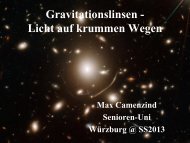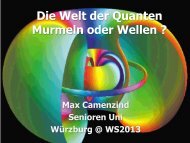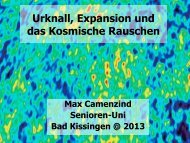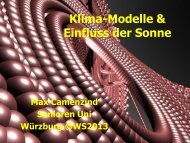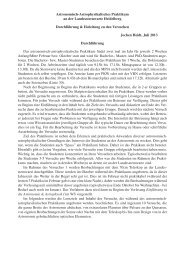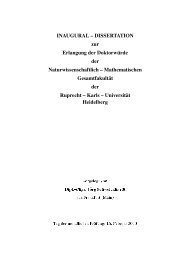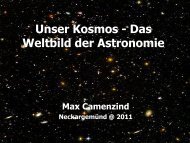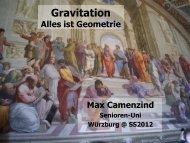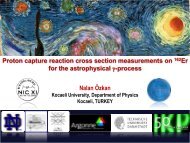Contents List of Figures
Contents List of Figures
Contents List of Figures
Create successful ePaper yourself
Turn your PDF publications into a flip-book with our unique Google optimized e-Paper software.
6.3 Fundamental Parameters for Jets 281<br />
The critical density contrast ηcrit can be estimated from the condition that the<br />
bow shock becomes transonic, vHS = cS. For relativistic beams vB c, we find<br />
ηcrit 10 −5 . For η < ηcrit, no bow shock will be found.<br />
For a more quantitative formulation one needs certain empirical relations between<br />
the elliptical’s blue magnitude MB, its s<strong>of</strong>t X–ray emission LX, the stellar<br />
velocity dispersion σ∗ (the Faber–Jackson relation), and the core radius Rc (Kormendy<br />
relation), assuming H0 = 75 (Bicknell 1995)<br />
log LX = 22.3 − 0.872 MB (685)<br />
log σ∗ = 5.412 − 0.0959 MB (686)<br />
log Rc = 11.7 − 0.436 MB . (687)<br />
We furthermore assume a density scaling for the ISM <strong>of</strong> the elliptical<br />
n(d) =<br />
n0<br />
[1 + (d/Rc) 2 ] δ<br />
(688)<br />
with δ 0.75 typically. Then the hotspot advance speed follows from pressure<br />
balance<br />
vHS(d) = vB<br />
X[1 + (d/Rc) 2 ] δ/2<br />
d/Rc + X[1 + (d/Rc) 2 . (689)<br />
] δ/2<br />
Here X = <br />
4LB/πΘ 2 R 2 cn0µmpc 3 with LB as the beam power, Θ the effective opening<br />
angle for the beam. A reasonable number is Θ 0.1 rad, at least for the inner<br />
jet regions. X corresponds to the above quantity √ χη for cylindrical beams. The<br />
temperature <strong>of</strong> the X–ray gas is not independent, but tied to the central stellar velocity<br />
dispersion, kT = 2.2µmpσ 2 ∗/δ (Falle 1987). There is evidence that the central<br />
gas density n0 is somewhat higher than the X–ray gas density nX, n0 = κnX with<br />
κ 3. The interstellar density declines quite rapidly at distances beyond a few kpc,<br />
observationally Rc 1 kpc. Hence the most likely regime for the jet’s decollimation<br />
due to hotspots having slowed down to subsonic speeds lies within roughly 10 kpc<br />
<strong>of</strong> the core.<br />
Gopal–Krishna & Wiita (2001) now evaluate the critical beam power L ∗ B for<br />
which the hotspot deceleration to subsonic velocities occurs at a distance d ∗ 3−10<br />
kpc from the core. 10 kpc is a typical distance at which jets flare in a sample <strong>of</strong><br />
radio galaxies. Laing et al. (1999) have studied a sample <strong>of</strong> 38 FR I sources giving<br />
a mean projected value <strong>of</strong> 3.5 kpc for the radial distance <strong>of</strong> the point where the<br />
kpc–scale jet first becomes visible, after passing through an emission gap.<br />
Now X can be scaled to<br />
X = C2<br />
√ <br />
LB/ n0Rc<br />
(690)



